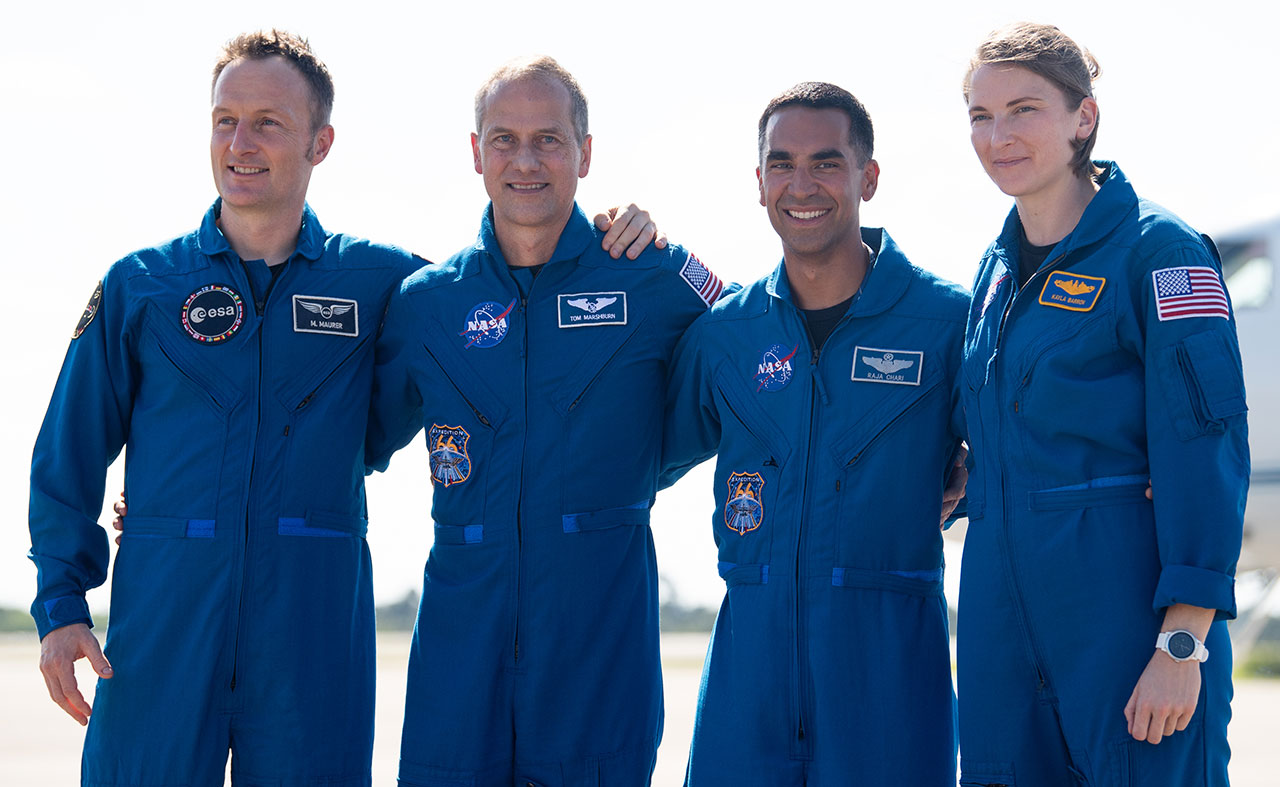L+600 and counting: ESA astronaut to be 600th person in space on SpaceX Crew-3 launch
"I was the lucky one to get the round number."

A German astronaut is set to become the 600th person to enter space and he will do so flying with a U.S. astronaut who once came close to being number 500.
Matthias Maurer with the European Space Agency (ESA) will gain the distinction of being the sexcentenarian space traveler when he launches to the International Space Station as a member of SpaceX's Crew-3 mission, currently scheduled for early Sunday morning (Oct. 31). Maurer is one of three first-time fliers on the four-person crew, including NASA astronauts Raja Chari and Kayla Barron, but he was identified by NASA as the designated milestone maker.
"I actually offered the place to Kayla, because she and I will be together [on the spacecraft], but I was the lucky one to get the round number," Matthias said on Tuesday (Oct. 26), soon after arriving at NASA's Kennedy Space Center in Florida for his upcoming launch. "It is okay, we will all have fun in space."
Live updates: SpaceX's Crew-3 mission to the space station for NASA
Related: How to watch SpaceX's Crew-3 astronaut launch online
Maurer's fourth crewmate, NASA astronaut Tom Marshburn, is flying for his third time. On Marshburn's first mission, a space shuttle flight in 2009, he was in a similar situation to Maurer, but to be the 500th to leave the planet. Ultimately, it was another crew member, Chris Cassidy, was was identified for the title based on where he was seated on board the orbiter Endeavour.
"I think my seat might be a few feet ahead of his but then you roll upside down, which might put me even more in the lead, but it is kind of hard to say," Marshburn told collectSPACE.com 12 years ago.
Aboard Endeavour, Marshburn was just a seat or two away of being number 500. Since that flight, his place on the list has changed.
Breaking space news, the latest updates on rocket launches, skywatching events and more!
"We are entering the era of commercial spaceflight and with all of the suborbital flights, they also count into the statistics," said Maurer on Tuesday.
As of a decade or so ago, the count was based on every person to fly above the Kármán line, the internationally-recognized boundary between Earth and space at 62 miles high (100 km). Not all commercial spaceflights reach that altitude though.
The Federal Aviation Administration (FAA) in recent years has begun awarding commercial astronaut wings for suborbital flights above 50 miles (80 km), the U.S. military's definition of the start of space since the late 1950s. Following that criteria, 14 more people make the list, including X-15 rocket plane pilots and Virgin Galactic SpaceShipTwo crew members.
Under that count, Cassidy slips six places, with a member of the STS-125 crew on space shuttle Atlantis becoming number 500 (perhaps Michael Good, who was seated in the same location on Atlantis as Cassidy was on Endeavour).
Maurer, who was chosen by ESA to become an astronaut in 2015, will also be the 12th German and 29th ESA astronaut to fly into space. As a member of the Expedition 66 crew, he will be the third German and 11th ESA astronaut to reside on the International Space Station for a long-duration stay.
Barron, who became a NASA astronaut in the same class as Chari in 2017, will be the 72nd women to fly into space, on either orbital or suborbital spaceflights, out of the soon to be 601 total spacefarers since 1961.
"Six hundred in 60 years, it makes for about 10 people a year, but I think in the next few years we'll see an exponential rise," said Maurer. "We're at the dawn of a new era for spaceflight."
Follow collectSPACE.com on Facebook and on Twitter at @collectSPACE. Copyright 2021 collectSPACE.com. All rights reserved.

Robert Pearlman is a space historian, journalist and the founder and editor of collectSPACE.com, a daily news publication and community devoted to space history with a particular focus on how and where space exploration intersects with pop culture. Pearlman is also a contributing writer for Space.com and co-author of "Space Stations: The Art, Science, and Reality of Working in Space” published by Smithsonian Books in 2018.
In 2009, he was inducted into the U.S. Space Camp Hall of Fame in Huntsville, Alabama. In 2021, he was honored by the American Astronautical Society with the Ordway Award for Sustained Excellence in Spaceflight History. In 2023, the National Space Club Florida Committee recognized Pearlman with the Kolcum News and Communications Award for excellence in telling the space story along the Space Coast and throughout the world.



